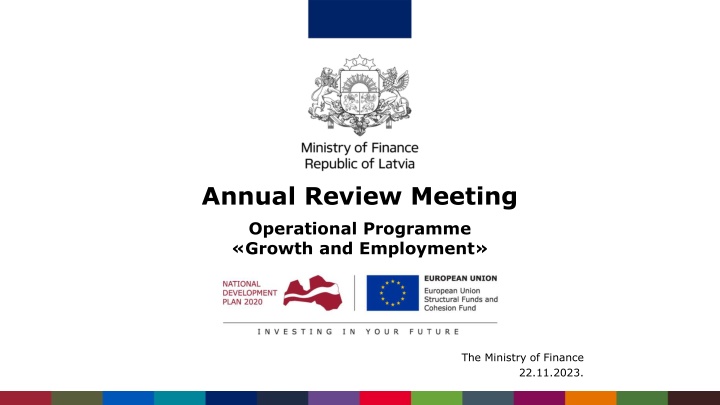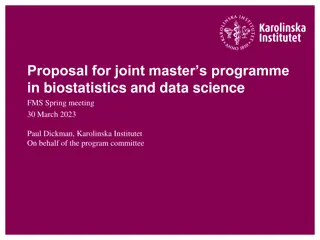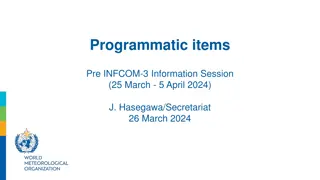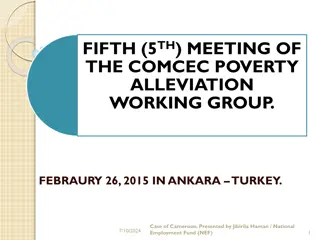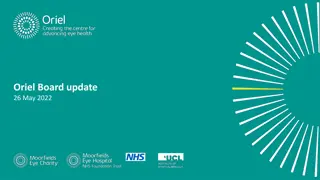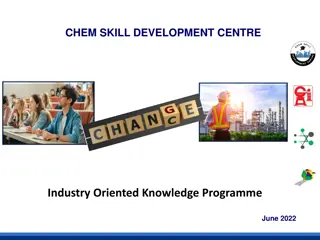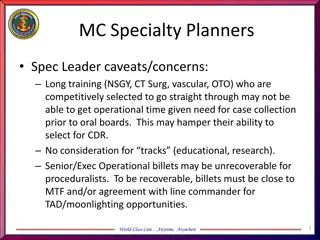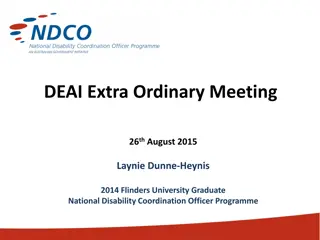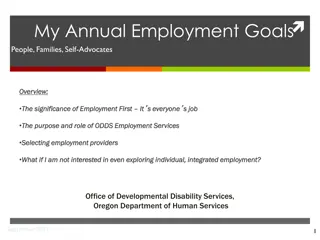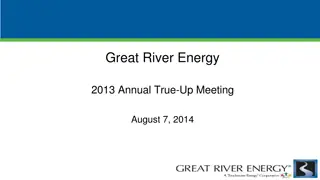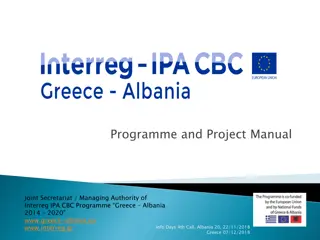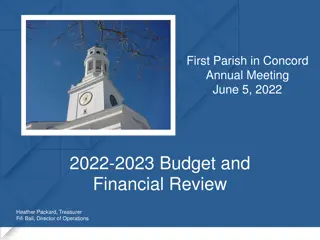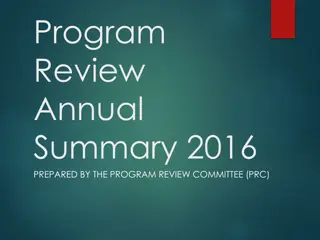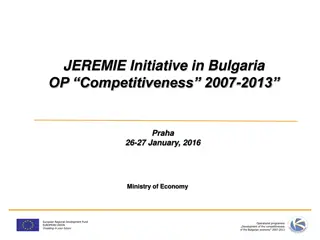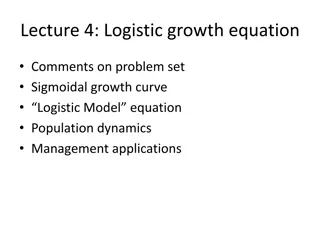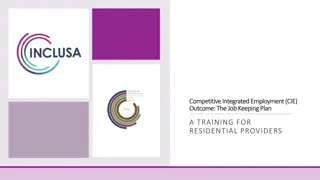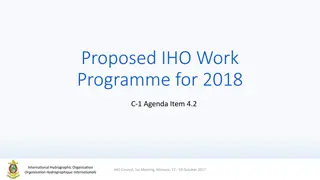Annual Review Meeting on Operational Programme Growth and Employment
This annual review meeting discusses the operational program's growth and employment status, strategic aspects of implementation, economic outlook, inflation forecast, and labor market trends. It covers topics like objectives, evaluations, EU Strategy for the Baltic Sea Region, and more.
Download Presentation

Please find below an Image/Link to download the presentation.
The content on the website is provided AS IS for your information and personal use only. It may not be sold, licensed, or shared on other websites without obtaining consent from the author.If you encounter any issues during the download, it is possible that the publisher has removed the file from their server.
You are allowed to download the files provided on this website for personal or commercial use, subject to the condition that they are used lawfully. All files are the property of their respective owners.
The content on the website is provided AS IS for your information and personal use only. It may not be sold, licensed, or shared on other websites without obtaining consent from the author.
E N D
Presentation Transcript
Annual Review Meeting Operational Programme Growth and Employment The Ministry of Finance 22.11.2023.
2. Strategic aspects of implementation 2.1. objectives and CSRs (current situation and prognosis); 2.2. Main findings of evaluations performed in 2023; 2.3. EU Strategy for the Baltic Sea Region (EUSBR). State of play of cooperation activities in the region. Overall economic outlook, achievement of strategic 2
2.1. Overall economic outlook, achievement of strategic objectives and CSRs 3
External demand slows Latvian economy because of swift increase of ECB s interest rate, and domestically households tend to consume less in 2023 20 10 6.7 4.0 3.4 2.9 2.9 2.5 0.6 0.0 -0.1 -1.1 0 -3.5 -10 -20 2018 2019 2020 2021 2022 1.c. 2023 2.c. 3.c 2024 2025 2026 Private consumption Government consumption Investments Changes in inventories Exports Imports GDP 4 Source: CSB, MoF forecasts
Average inflation in 2023 is forecast at 10%, decreasing to 2% at the end of the year. In 2024, average inflation will reach 2.2% Contribution to annual inflation, % CPI y-o-y change, % 24 Commodity groups 2022 Jan Feb Mar Apr Mai Jun Jul Aug Sep 21 Inflation, total 21,5 20,3 17,3 15,1 12,1 7,9 6,4 5,4 3,3 17,3 (01) Food and non- alcoholic beverages (02.1.) Alcoholic beverages 18 28,2 25,3 24,1 20,2 17,9 14,4 11,2 8,2 5,7 21,6 8,9 9,0 10,2 8,3 9,2 9,3 9,7 8,8 10,2 5,5 15 (02.2.) Tobacco products 4,9 5,5 6,9 7,8 7,4 7,2 6,5 6,8 6,8 5,3 12 ..(04.1.) Rentals for housing -0,2 -1,2 0,8 3,2 -0,9 0,3 0,2 1,1 5,7 2,9 9 ..(04.5.1.) Electricity 89,8 90,2 60,2 56,2 25,2 6,3 13,0 -6,7 -27 36,2 ..(04.5.2.) Gas 65,7 65,6 62,8 60,4 6,2 6,1 -33 -19 -19 6 99,2 ..(04.5.5) Heat energy 69,6 66,4 62,3 60,2 50,4 27,0 17,8 11,8 2,3 52,9 3 (06) Health care 10,3 10,1 9,9 10,0 10,4 10,3 10,6 9,6 9,4 6,9 0 ....(07.2.2.) Fuels for transport ..(07.3.) Transport services (09) Recreation and culture (11) Restaurant and hotel services (12) Miscellaneous goods and services 17,8 12,0 -7,5 -11 -19 -26 -22 -11 -4,3 38,2 -3 3,7 6,2 9,4 8,9 10,2 10,3 11,7 6,5 6,2 2,5 I III V VII IX XI I III V VII IX XI I III V VII IX 11,2 11,5 11,4 12,8 11,4 9,9 10,0 8,9 7,5 6,3 2021 2022 2023 13,4 18,6 18,2 17,5 15,8 17,4 13,3 12,7 11,7 9,3 Food Energy* Fuels Other goods and services CPI, % 17,4 17,2 15,6 14,3 14,2 12,5 12,3 10,1 9,6 11,8 5 Source: CSB, MoF calculations
The slowdown has not been felt in the labour market, unemployment continues to decrease, wages are growing rapidly, real wage turned positive in the Q2 Employment and unemployment, LFS Average gross wage by sectors in 1H of 2023, euro and changes y-o-y, % 18 950 Hotels, catering 14.3% 16 900 Education 13.8% 14 Other services 10.9% 850 12 Real estate 11.1% 10 800 Arts, entertainment 9.2% 8 Administrative 8.4% 750 6 Trade 14.6% 4 700 Construction 10.0% 2023 II 2011 2012 2013 2014 2015 2016 2017 2018 2019 2020 2021 2022 2023 I Manufacturing 12.9% Transport 17.3% Number of employed persons (rhs) Unemployment rate, % TOTAL 12.2% Real and gross wage dynamics, y-o-y, % Water supply 16.2% 12 Agriculture 21.2% 10 8 Health care 0.0% 6 Mining 19.6% 4 Public administration 14.2% 2 0 Professional services 11.9% -2 Energy 17.9% -4 -6 ICT 11.9% -8 Financial services 10.0% -10 2023 II 2011 2012 2013 2014 Real wage 2015 2016 2017 2018 2019 2020 2021 2022 2023 I 0 500 2022 1 H 1000 1500 2000 2500 6 +2023 1 H Gross wage Source: CSB
The construction industry was negatively affected by rising costs and uncertainty about future developments, first half of 2023 comes with noticeable increase Construction costs; annual increase % Construction output; comparable prices; indices 35% -6,2%-11,3% 30% 160 25% 140 +16,1% 20% 120 15% 100 10% 80 5% 60 0% 40 -5% 20 II IX II IX II IV IV IV V VII XII V VII XII V VII I X I X I III III III VI XI VI XI VI VIII VIII VIII 0 II IV II IV II IV II IV II IV II IV II IV II IV II I I I I I I I I I III III III III III III III III 2021 Total 2022 2023 2015 2016 2017 2018 2019 2020 2021 2022 2023 Construction materials Wage Machinery Construction output; current prices; mln euro Production in construction in Baltics; indices 2015=100 170 900 +0,6%+6,4% +26,1% 160 800 150 700 140 600 130 500 120 400 110 300 100 90 200 80 100 I II IIIIV I II IIIIV I II IIIIV I II IIIIV I II IIIIV I II IIIIV I II IIIIV I II IIIIV I II 0 2015 2016 2017 2018 2019 2020 2021 2022 2023 IV IV IV IV IV IV IV IV II II II II II II II II II I I I I I I I I I III III III III III III III III 2015 2016 2017 2018 2019 2020 2021 2022 2023 Estonia Latvia Lithuania Source: CSB, Eurostat
Higher investment activity will be one of the main drivers of economic development in 2023 EU funds and Recovery and Resilience Facility (RRF) national budget expenditure forecast for 2023-2026, current prices, mln euro Changes of gross fixed capital formation by asset type mln euro and % (RHS) , y-o-y 1,800 250 25 1,600 200 20 1,400 150 15 653 684 455 1,200 100 10 1,000 281 50 5 800 423 51 11 127 0 0 12 600 990 948 -50 -5 400 720 719 712 631 596 594 581 225 544 -100 -10 404 200 166 0 -150 -15 2015 2016 2017 2018 2019 2020 2021 2022 2023 2024 2025 2026 I II III IV I II III IV I II III IV I II III IV I II 2019 2020 2021 2022 2023 Actual data 2014-2020 Forecast RRF 2007-2013 2021-2027 Construction Machinery and equipment Intellectual property products Other fixed assets In total, % (rhs) 8 Source: CSB, MoF
Government policies to overcome energy and inflation crisis have been successful Temporary state support to cover increased energy and inflation costs to individuals, households and companies ( 1.5% of GDP in 2022 and 1% in 2023), including SAFE amounting to 60 mio EUR; Review of income tax, pensions and social benefits Social indicators have slightly improved: % of people at risk of poverty or exclusion and/or people living in households with very low work intensity, remain stable from 2021 (26.1%) to 2022 (26%). % of children (aged less than 18) at risk of poverty or social exclusion 2021 (20,1%) to 2022 (19,8%) People at risk of poverty or social exclusion by age (65 year or over) 2021 (45,9%) to 2022 (42,6%) Overall energy consumption has decreased - gas by 40% and electricity by 3.7% comparing 2022 with 2021. Support measures did not hamper transmition of energy price signals to consumers. For 2023/2024 heating season temporary support measures more targeted if needed. 9
Macroeconomic and socioeconomic risks for economic development and EU fund implementation Prolonged high overall uncertainty and subdued growth for main trading partners. Geopolitical risks that have materialised: gas imports from Russia from 100% to 0% in one year unprecedented inflation driven mostly by energy cost increases -> disruptions in project implementation export share of goods and services to Russia down to 4,9% in 2022 from 11.7% in 2014 increased security risks on external border in addition to economic development challenges Increased borrowing costs and high prices impact financial capacity of economy players, beneficiaries, especially in private sector. Demographic trends in medium term as of 2025 number of persons employed expected to decline (end of pension reform, shrinking population). 10
Opportunities and strengths Good economic foundation: Sound fiscal policy and low public, household and corporate debt level Resilient and diversified economy, adjustment to shocks related to Russia s war in Ukraine better than expected New opportunities related to green and digital transition ->structural changes in economy: Increased local production of green energy Possibilities to become part of green energy production chain, geographical advantages (net-zero industry and wind energy) Increasing ICT services and goods exports despite global headwinds Cohesion policy and RRF funding available for long term structural policies 11
Progress in achievement of Latvias strategic objectives EU 2020 Agenda Latest data Target 2020 Employment rate by sex, age group 20-64 78% (2023, 2Q) 73,0% Tertiary educational attainment by sex, age group 30-34, % 45.7% (2022) 34-36% Early leavers from education and training, age group 18-24, % 6,7% (2022) 10,0% Climate change and Energy: % generated from renewable sources 42,1% (2021) 40,0% Total GHG emissions, Mt CO2 equivalent 10,5 (2020) 12,2 Iimprovement in energy efficiency (energy savings compared to 2008, Mtoe) 0,897 (2020) 0,67 People at risk of poverty or exclusion and/or people living in households with very low work intensity, % 26 %(2022) 21,0% Gross domestic expenditure on research and development, (% of GDP) 0,74% (2021) 1,5% 12
EU funds have contributed to implementation of CSRs as they have evolved. Long-term challenges remain. 2023 CSRs more focused on green and digital tranition Social inclusion and health(2013/2014) Infrastructure and support to economy (2013/2014) Improve connectivity with EU energy networks and take steps towards liberalisation of the natural gas market Education and research (2013/2014) Governance (2013/2014) Implement reforms in the field of vocational education and training, and improve the quality and accessibility of apprenticeships. Reforms of higher education - the establishment of a quality-rewarding financing model, reform of the accreditation system, consolidation of the institutions and promotion of internationalization. Modernisation research institutions based on the on- going independent assessment. Tackle long-term and youth unemployment by increasing coverage and effectiveness of active labour market policies and targeted social services. Improve the employability of young people, establish comprehensive career guidance. Tackle high rates of poverty and social exclusion by reforming the social assistance. Ensure better targeting and increase incentives to work. Improve the cost-effectiveness, quality and accessibility of the healthcare system. Take measures to improve management and efficiency of the judiciary, in particular to reduce the backlog and length of procedures. Take steps to improve the insolvency regime and the mediation laws. Step up public administration reforms, including by implementing state owned enterprise management reform and increasing institutional and financial independence of the Competition Council. Pursue efforts to further increase energy efficiency in transport, buildings and heating systems. Infrastructure and support to economy (2023) Governance (2023) Social inclusion and health (2023) Education and research (2023) strengthen the adequacy of healthcare and social protection. Step up policy efforts aimed at the provision and acquisition of skills and competences needed for the green transition. foster the green and digital transitions Reduce overall reliance on fossil fuels and strengthening energy efficiency measures Improve access to finance for small and medium-sized enterprises speedy implementation of cohesion policy programmes, in close complementarity and synergy with the recovery and resilience plan 13
2.2. Main findings of evaluations performed in 2022 14
Implementation of the evaluation plan and main findings of evaluations performed in 2023 More information will be presented in 2021 2027 Annual Performance Review meeting and 2014 -2020 Monitoring Committee The EU funds Evaluation plan 2021-2027 was approved by Monitoring Committee January 26, 2023. Main focus during 2023 continuation of ex-post evaluations of the 2014 -2020 EU fund planning period Information on the evaluation activities available at: https://www.esfondi.lv/profesionaliem/izvertesana 15
2.3. EU Strategy for the Baltic Sea Region (EUSBR). State of play of cooperation activities in the region 16
EUSBSR is an important tool for the growth of Latvia allowing to coordinate national needs and challenges at regional level and facilitate joint implementation of projects SOs and main activities within the OP where particular activities contribute to achieving the overall goals of the EUSBSR - 2,48 bn EUR (53,6%) of OP funding (4,64 bn EUR)*: SAVE THE SEA CONNECT THE REGION INCREASE PROSPERITY 4 SOs: Clear water in the sea A rich and healthy world of plants and animals Clean and safe shipping ESI funds: 250 M EUR (-18 MEUR*) 9 SOs +2 React-EU SOs: Good transport conditions Reliable energy markets Better cooperation in the fight against cross-border crime ESI funds: 1 281 M EUR (+53 MEUR*) 11 SOs +3 React-EU SOs: EUSBSR as strengthening implementing market Improved competitiveness of the Baltic Sea region Climate change risk prevention management ESI funds: 957 M EUR (-3 MEUR) a leader in and the single global adaptation, and *Compared to the funding for previous year (2022) (2,45 bn EUR (52,2%) of OP funding (4,64 bn EUR) 17
State of play of EUSBR cooperation activities in the region Since 2016 Latvia is a member of the EUSBSR ERDF Managing Authorities Network. 66 projects* with participation of Latvian partners have been approved under the Interreg Baltic Sea Region Programme 2027 contributing to the implementation of the EUSBSR - EUR 18.9 million ERDF allocated to Latvian partners. The Annual EUSBSR Forum took place in Riga on 4-5 October 2023. Latvia will continue to facilitate cross-sectoral cooperation in the region during its Presidency in EUSBSR National Coordinators Group from July 2023 till June 2024. 2021- * Data as of 24.10.2023 18
Annual Review Meeting Operational Programme Growth and Employment The Ministry of Finance 22.11.2023.
